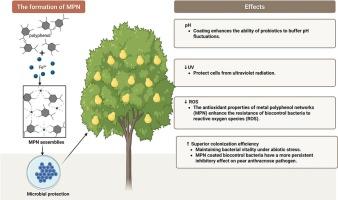金属酚网络提高了velezensis DM14对梨炭疽病的生物防治效果
IF 4
1区 农林科学
Q2 BIOCHEMISTRY & MOLECULAR BIOLOGY
引用次数: 0
摘要
梨炭疽病是一种严重影响梨生产的采后病害。利用拮抗微生物进行生物防治为杀菌剂提供了一种有希望的替代方法。不幸的是,这些微生物容易受到恶劣环境条件的影响,这限制了它们的现场应用。为了克服这一限制,我们研究了从健康梨果实表面分离得到的velezensis DM14的生物防治潜力,该菌株对核桃炭疽杆菌具有显著的抑制作用。显微镜下分析发现,暴露于DM14的发酵提取物(RFE)后,C. fructicola细胞发生了显著的形态学变化,包括胞质解体和空泡化等胞内破坏,最终导致细胞死亡。虽然DM14的发酵提取物在体外是有效的,但提高DM14活细胞的存活率是实际应用的关键。因此,我们使用基于金属酚网络(MPN)封装的一步保护DM14。在氧化胁迫条件下,mpn包被的DM14在果实损伤中显示出较高的定殖率。重要的是,与未包被的DM14相比,mpn包被的DM14对梨炭疽病的预防能力提高了约37%。此外,MPN涂层策略提高了受感染水果伤口对氧化微环境的耐受性。总的来说,这种微生物包封策略是一种很有前途的方法来保护脆弱的拮抗微生物,为可持续农业提供了有吸引力的途径。本文章由计算机程序翻译,如有差异,请以英文原文为准。

Metal–phenolic networks improve biocontrol effect of Bacillus velezensis DM14 against pear anthracnose
Pear anthracnose is a serious postharvest disease that affects pear production. The use of antagonistic microorganisms for biological control provides a promising alternative to fungicides. Unfortunately, these microorganisms are susceptible to harsh environmental conditions, which limits their field application. To overcome this limitation, we investigate the biocontrol potential of Bacillus velezensis DM14, which was isolated from the surface of healthy pear fruits and exhibits significant inhibitory effects on Colletotrichum fructicola. Microscopic analysis revealed that C. fructicola cells exposed to secreted fermentation extract raw fermentation extract (RFE) of DM14 underwent significant morphological changes, including intracellular disruptions such as cytoplasmic disintegration and vacuolization, ultimately leading to cell death. While the fermentation extract of DM14 was effective in vitro, enhancing the survival of live DM14 cells is essential for practical application. Therefore, we use a one-step protection based on metal-phenolic network (MPN) encapsulation for DM14. This MPN-coated DM14 has shown a higher colonization rate under oxidative stress conditions in fruit wounds. Importantly, compared with uncoated DM14, the MPN-coated DM14 enhanced the prevention of pear anthracnose by approximately 37 %. Furthermore, the MPN coating strategy improved the tolerance to oxidative microenvironments in infected fruit wounds. Overall, this microbial encapsulation strategy is a promising way to protect fragile antagonistic microorganisms, providing attractive avenues in sustainable agriculture.
求助全文
通过发布文献求助,成功后即可免费获取论文全文。
去求助
来源期刊
CiteScore
7.00
自引率
8.50%
发文量
238
审稿时长
4.2 months
期刊介绍:
Pesticide Biochemistry and Physiology publishes original scientific articles pertaining to the mode of action of plant protection agents such as insecticides, fungicides, herbicides, and similar compounds, including nonlethal pest control agents, biosynthesis of pheromones, hormones, and plant resistance agents. Manuscripts may include a biochemical, physiological, or molecular study for an understanding of comparative toxicology or selective toxicity of both target and nontarget organisms. Particular interest will be given to studies on the molecular biology of pest control, toxicology, and pesticide resistance.
Research Areas Emphasized Include the Biochemistry and Physiology of:
• Comparative toxicity
• Mode of action
• Pathophysiology
• Plant growth regulators
• Resistance
• Other effects of pesticides on both parasites and hosts.

 求助内容:
求助内容: 应助结果提醒方式:
应助结果提醒方式:


